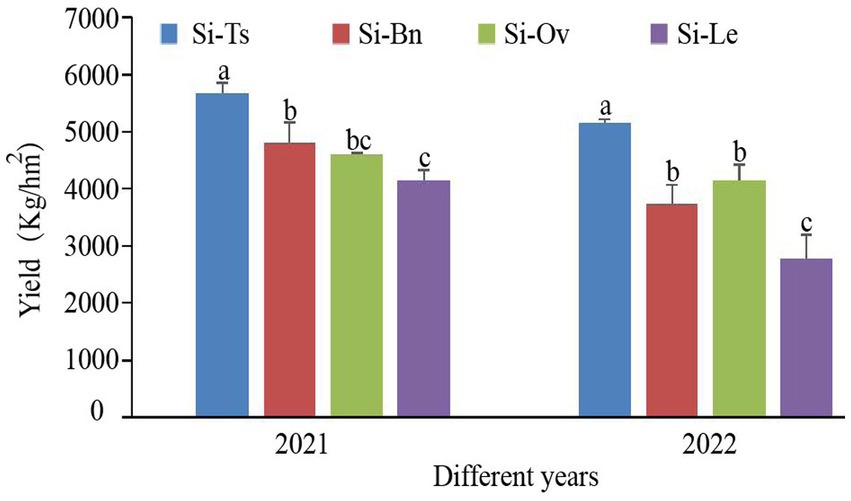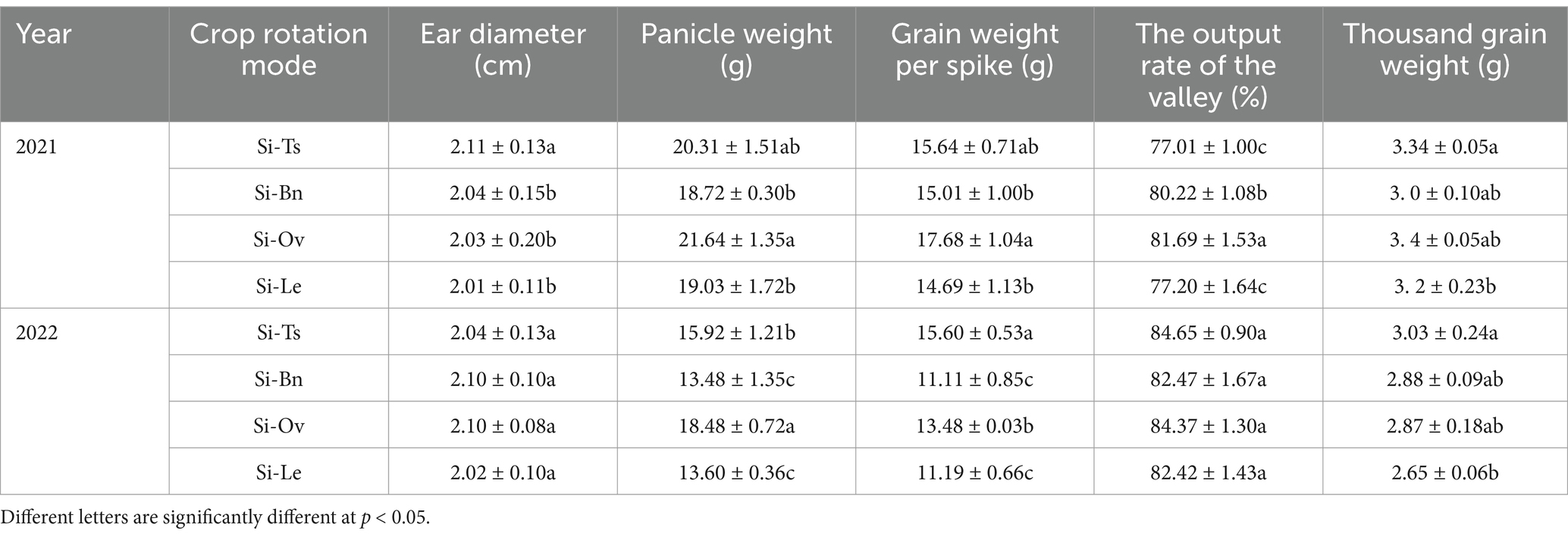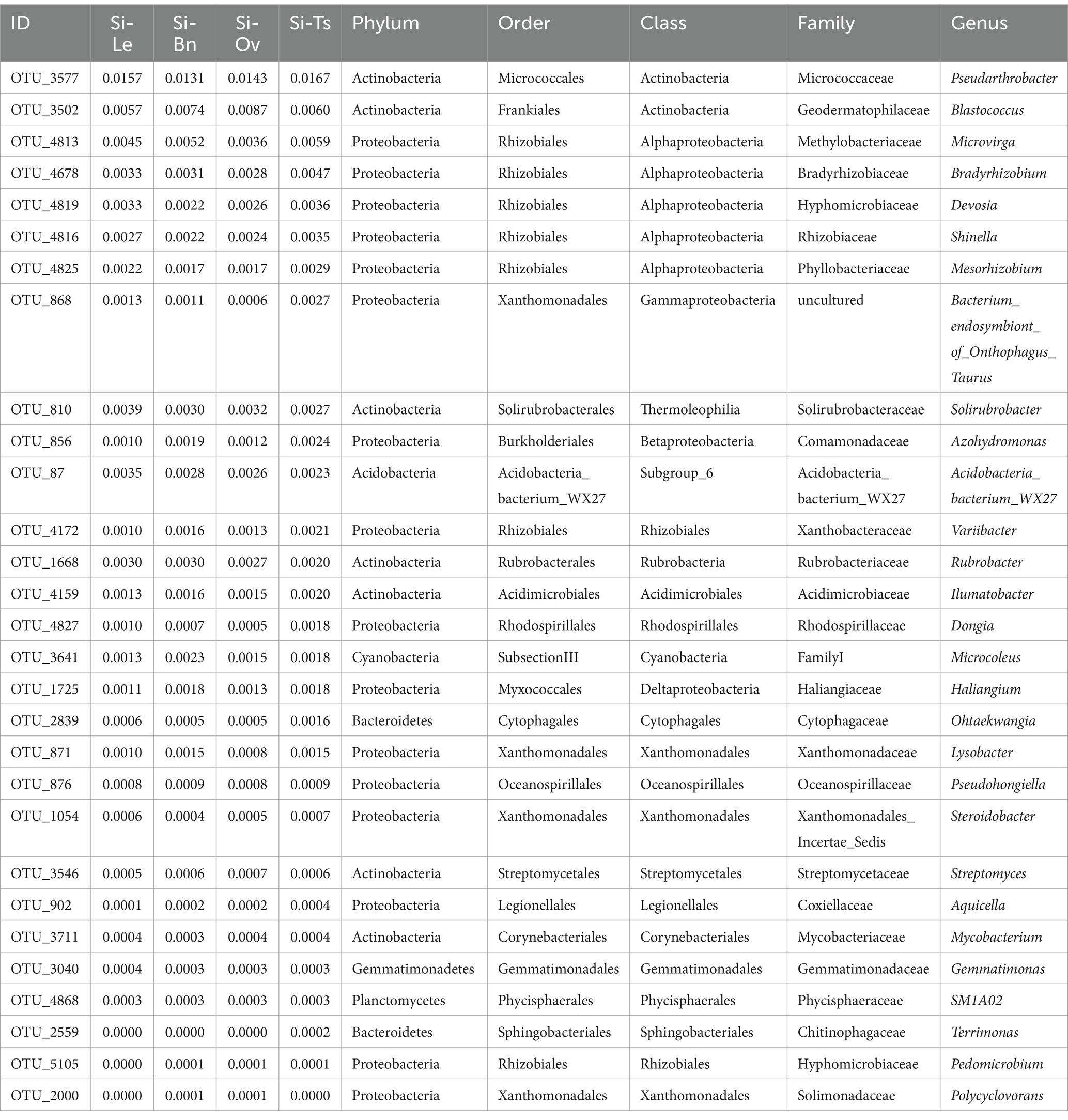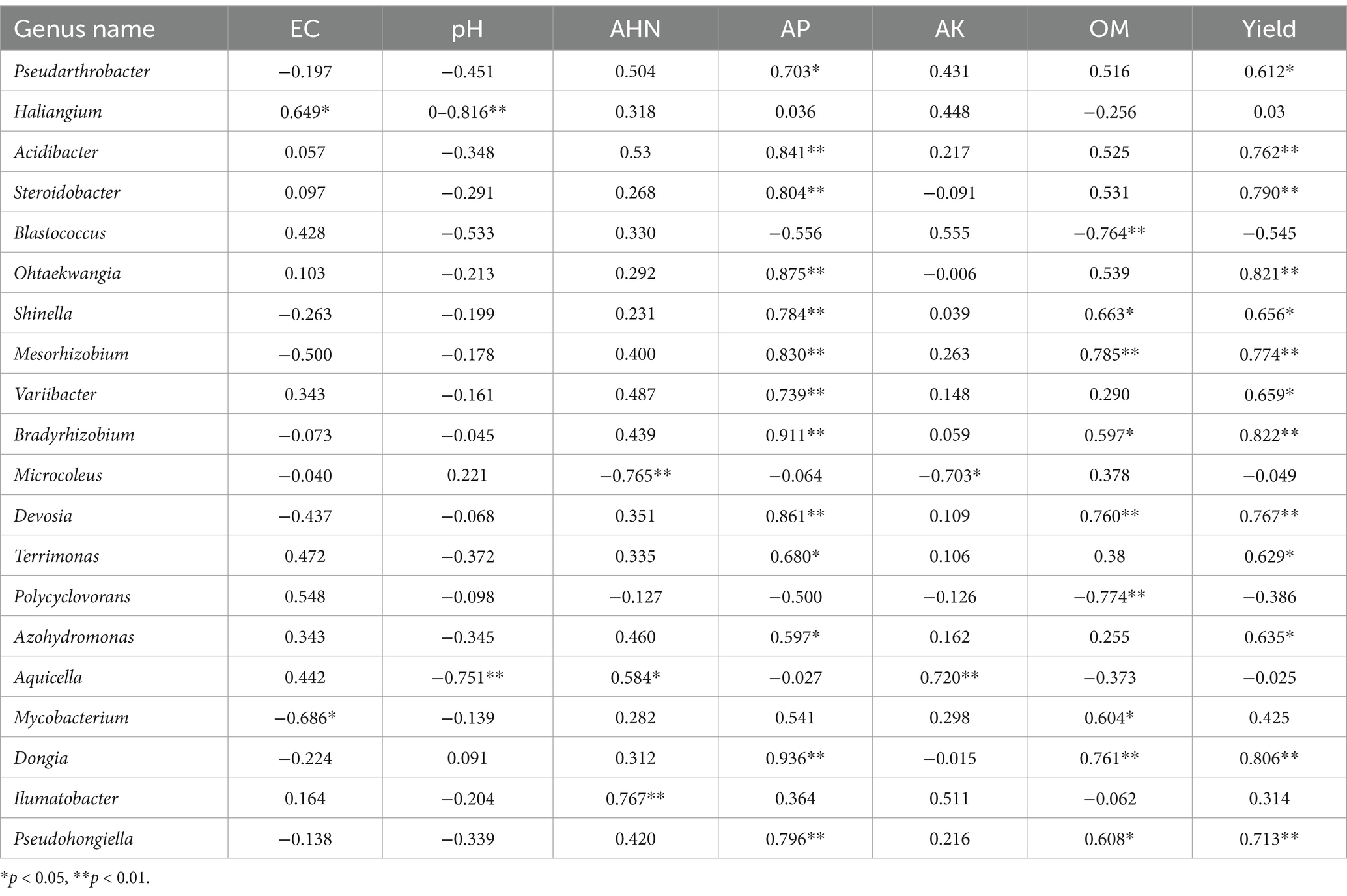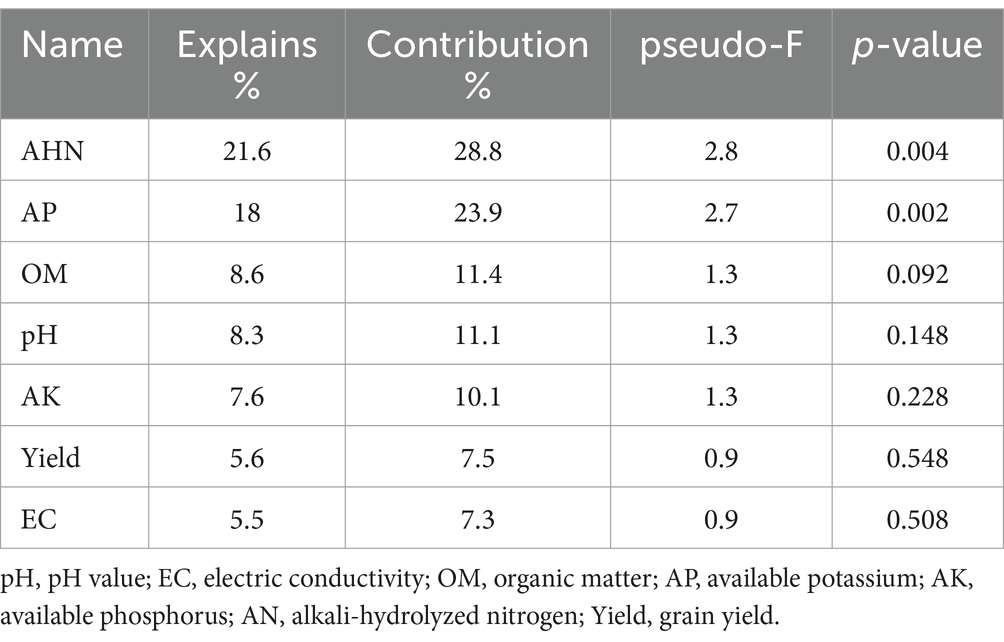- 1Key Lab of Crop Drought Tolerance Research of Hebei Province, Institute of Dry Farming, Hebei Academy of Agriculture and Forestry Sciences, Hengshui, China
- 2Hebei Center for Ecological and Environmental Geology Research, Hebei GEO University, Shijiazhuang, China
China is a largely agricultural country, while the drought climate in northern of China is more and more severe, which influences on the agriculture production seriously. The over-exploitation of groundwater is a critical issue in the low plains of Hebei Province. To address this challenge, the government has implemented winter fallow and rain-fed crop planting policies. In alignment with these policies and ensure the sustainable utilization and protection of cultivated land, this study conducted long-term field experiments using three green manure with foxtail millet rotation models at Shenzhou District experimental base, Hengshui City, Hebei Province. Thefoxtail millet yield, soil bacterial community characteristicsc, and soil physicochemical properties were analyzed to identify an optimal green planting model for promoting sustainable agricultural development. The results revealed that three green manure-foxtail millet rotation models significantly increased millet yield compared to millet-rallow rotation. The foxtail millet–Triticum secale rotation model achieved the highest yield increase, with a 12.47% average improvement in thousand-seed weight in 2021 and 2022 compared to millet-fallow rotation. This rotation model also led to the largest increase in available phosphorus content, which rose by 46.16 and 37.56% in 2021 and 2022, respectively. Furthermore, the diversity and richness of the soil rhizosphere bacterial community were highest under this model. Beneficial bacterial genera, including those in the Phyla Bacteroidetes and Proteobacteria, were more abundant, while the relative abundance of Acidobacteria was lowest. Correlation analysis showed that soil organic matter, available phosphorus, and millet yield were positively correlated with multiple genera of Bacteroidetes and Proteobacteria but negatively correlated with Acidobacteria. In conclusion, the foxtail millet–Triticum secale rotation model effectively improved the soil environment and supported stable, high millet yields. These findings provide a theoretical basis for advancing crop rotation strategies and offer technical support for sustainable agricultural development.
1 Introduction
China is a largely agricultural country, while the drought climate in northern of China is more and more severe, which influences on the agriculture production seriously (Li et al., 2023). The over-exploitation of groundwater is a critical issue in the low plains of Hebei Province. In alignment with these policies and ensure the sustainable utilization and protection of cultivated land, the crop types that use water efficiently and planting patterns were in urgent demand. However, Foxtail millet (Setaria italica) is a short-season, drought and barren-tolerant crop, making it highly suitable for cultivation in arid and mountainous regions across northern and southern China (Nielsen and Vigil, 2017). Given the increasing global challenges posed by drought, dry farming systems have garnered significant attention (Diao and Cheng, 2017). Due to the millet having characteristics of rich nutrition, the balance of various components, excellent storage properties, making it an ideal crop for addressing dietary nutritional needs and serving as a strategic reserve in water-scarce scenarios (Zhang et al., 2018). These unique attributes have contributed to the rising demand and development of the millet industry. However, continuous foxtail millet-rallow rotation to achieve high yields has led to significant challenges, including reduced crop productivity, severe soil borne diseases, and declining soil quality (Zhang et al., 2024). Crop rotation offers an effective strategy to mitigate the adverse effects of continuous cropping (Anurag et al., 1997; Sammauria et al., 2020). Reasonable crop rotations can balance soil nutrient levels, improve soil physicochemical properties, regulate microbial communities, and enhance crop yields (Horn and Alweendo, 2011). For instance, millet rotations with crops such as pigeon pea or Urochloa have been shown to reduce soil pH and aluminum levels while increasing calcium, magnesium, potassium, and iron content. These rotations also improve soil structure and physical properties relative to fallow systems (Nascente and Stone, 2018). Furthermore, millet rotations promote complex bacterial community networks abundantly, enriching taxa such as Actinobacteria, Chloroflexi, and Proteobacteria (Li et al., 2024). Despite these benefits, how specific green manure-millet rotations affect soil properties and bacterial communities is unclear.
Green manure is a vital agricultural management measure that enhances soil fertility, accelerates nutrient cycling, and improves crop yields when returned to the soil (Zhang et al., 2017; Yang et al., 2023). Green manure crops, including grasses and legumes, influence the availability of carbon and nitrogen, with legumes fixing atmospheric nitrogen and grasses contributing higher carbon levels (Khan et al., 2020). These differences also influence on soil microbial communities, further improving soil quality (Chavarría et al., 2016; Xu et al., 2023). Despite of so many advantages, the adoption of green manure remains limited. Expanding the utilization of green manure in rotation systems is a promising strategy for increasing crop yields and preserving environmental health (Li et al., 2020). Investigating the effects of green manure-millet rotations on soil chemical and biological properties is particularly relevant in northern China.
Soil microorganisms are crucial for driving biogeochemical cycles in agroecosystems (Xia et al., 2023). Among these, soil bacteria play significant role in decomposing green manure residues, cycling nutrients, and ultimately react on the crop productivity (Leite et al., 2021). Recent studies have demonstrated strong correlations between specific bacterial taxa and soil properties, positioning bacterial communities as valuable indicators of soil quality across ecosystems (Trivedi et al., 2016; Qian et al., 2022). The research has shown that milk vetch as green manure alters bacterial communities in paddy soils and significantly correlates with soil pH in rice-green manure systems (Yang et al., 2023; Gao et al., 2021). Additionally, rapeseed manure has been shown to enhance soil nutrients, enzyme activities, bacterial diversity, and the prevalence of beneficial bacteria (Li et al., 2019). However, the mechanisms underlying changes in soil quality and bacterial communities under different green manure-millet rotations remain largely unexplored. To address these gaps, we conducted a five-year field experiment to evaluate the effects of four green manure-millet rotation systems (fallow-millet, Triticum secale-millet, Brassica napus L.-millet, and Orychophragmus violaceus-millet) on millet yield, soil chemical properties, and soil bacterial communities. The content of this study were to: (1) Assess the impact of green manure-millet rotation systems on millet yield and soil chemical properties. (2) Investigate how soil bacterial community composition responds to different rotation systems. (3) Explore the relationships between soil bacterial communities, chemical properties, and millet yield across different rotations.
2 Materials and methods
2.1 Site description and experimental design
The green manure-foxtail millet rotation experiment was conducted in Hujiachi Town (37°44′N, 115°47′E), Hengshui City, Hebei Province, North China. Established in 2017. The experiment site is characterized by a warm temperate continental monsoon climate, with an annual mean temperature of 12.4°C and an average annual precipitation of 550 mm, predominantly occurring from June to September. The soil at the site is classified as loam fluvo-aquic soil. At the start of the experiment, the chemical properties of the topsoil (0–20 cm) were as follows: organic matter (OM) content of 20.0 g kg−1, alkali-hydrolyzable nitrogen (AN) of 70.66 mg kg−1, available phosphorus (AP) of 33.81 mg kg−1, and available potassium (AK) of 190.52 mg kg−1.
The experiment followed a randomized block design with three replicate plots per treatment. Four rotation treatments were implemented: (1) Fallow-millet rotation (Si-Le) (Control), (2) Triticum secale-millet rotation (Si-Ts), (3) Brassica napus L.-millet rotation (Si-Bn), (4) Orychophragmus violaceus-millet rotation (Si-Ov) For winter green manure, Triticum secale, Brassica napus L., and Orychophragmus violaceus were utilized. Millet was sown in late June and harvested in late September. The cultivars used in the study were as follows: Henggu 13 for millet, Zhongai 1048 for Triticum secale, Hengyou 8 for Brassica napus L., and a conventional Orychophragmus violaceus variety. Millet planting adopt the strategy of sowing after rain and not watering the whole growth period, using compound fertilizer (25 kg/acre) as the base fertilizer. The long-term experiment spanned five consecutive years (2018–2022), with consistent field management practices across all plots except for the variation in winter crop species used in the rotations.
2.2 Soil sampling and millet harvest
After the millet ripened, grain yields were determined by a single harvest from each plot. Yield components, including ear diameter, panicle weight, grain weight, and thousand-seed weight, were measured in the laboratory. The yield of millet (kg/hm2) were converted by measuring the millet yield of 100 m2. Following the millet harvest in 2021 and 2022, soil samples were collected from the top 0–20 cm layer for physiochemical property analysis. Five soil cores were taken from each plot and combined into a single composite sample. In September 2021, a total of 20 composite soil samples (four treatments × five replicates) were collected. Collected the plants (Z-shaped sampling method), removed the bulk soil at the root, placed them in a foam box filled with dry ice, in a dark environment, and returned to the laboratory as soon as possible; In a sterile workbench, shaked the plant roots, removed the loose soil in the roots, and collected the residual soil from the roots with a sterile brush for further analysis. Each soil sample was divided into two subsamples: one was passed through a 2-mm sieve and air-dried for physiochemical property analysis, while the other was stored at −80°C for DNA extraction.
2.3 Soil chemical property analysis
Soil pH was measured using a pH meter (soil-to-water ratio of 1:2.5) and the electrical conductivity (EC) was evaluated using electrode method. Soil organic matter (OM) was determined by potassium dichromate oxidation with external heating (Shen et al., 2021). Soil alkali-hydrolyzed nitrogen (AN) was determined using alkaline hydrolysis diffusion method (Cheng et al., 2023 Wan et al., 2024). The available phosphorus (AP) was determined using 0.5 mol L−1 NaHCO3 extraction-molybdenum antimony anticolorimetric method (Zhu et al., 2021). The available potassium (AK) is determined by flame photometry (Fu et al., 2020).
2.4 Soil microbial DNA extraction and illumina NovaSeq sequencing
Microbial DNA was extracted from 0.5 g of soil using a genome extraction kit (DP336, Beijing Tiagen Biotechnology Co., Ltd.). DNA quality was assessed using 1% agarose gel electrophoresis. Specific primers with barcodes were designed for the designated sequencing region. PCR products were amplified, detected by agarose gel electrophoresis, and purified using the Agencourt AMPure XP nucleic acid purification kit. Denatured sodium hydroxide was used to produce single-stranded DNA fragments, which were sequenced using the Illumina MiSeq platform (Allwegene technology Co., Ltd., Beijing). The V3-4 hypervariable region of bacterial 16S rRNA gene were amplified with the universal primer 338F (5′-ACTCCTACGGGAGGCAGCAG-3′) and 806R (5′-GGACTACNNGGGTATCTAAT-3′). The quality control was performed on the raw sequencing data to generate optimized sequences. Operational taxonomic unit (OTU) clustering and annotation were subsequently conducted (Rognes et al., 2016). Alpha and beta diversity analyses were performed to assess bacterial diversity (Amato et al., 2013; Wang L. et al., 2022; Wang X. Y. et al., 2022). Annotation results provided classification information at all levels, allowing for correlation analysis of sample composition and differences in community structure (Segata et al., 2011). Sequencing data are available in the Sequence Read Archive (SRA) database at NCBI (accession number: PRJNA733689).
2.5 Statistics
One-way analysis of variance (ANOVA) was performed using SPSS 21 software to evaluate differences in yield components, soil chemical properties, and bacterial relative abundance across rotation models. Tukey’s test was applied for multiple comparisons at a significance level of p < 0.05. Principal component analysis (PCA) was used to analyze the beta diversity of bacterial communities. Heat maps illustrating bacterial abundance at different genus levels were generated using Origin 2022. Redundancy analysis (RDA) was conducted with CANOCO 5.0 software to evaluate correlations between soil chemical properties and bacterial genera (Zeng and An, 2021). Phylogenetic tree was constructed using the nearest neighbor association method in MEGA 6.0 software to analyze bacterial colony characteristics (Wei et al., 2020). Data processing and visualization were performed using Microsoft Excel 2010 and DPS 7.05 software.
3 Results
3.1 The variation of millet yield
The millet yields in three manure-rotation patterns are significantly different from that in Si-Le in 2021 and 2022. In 2021, the grain yield of millet followed the order Si-Ts > Si-Bn > Si-Ov > Si-Le, and the grain yield of Si-Ts was the highest (5676.45 kg-hm−2), which was 36.72% higher than that of Si-Le, and that of Si-Bn was 15.63% higher than that of Si-Le. In 2022, the yield of millet was Si-Ts > Si-Ov > Si-Bn > Si-Le, and the yield of Si-Ts was the highest (5152.34 kg. hm−2), which was significantly increased by 85.67% compared with that of Si-Le. Additionally, The yield of Si-Bn and Si-Ov was 34.77% and 49. 56% obviously higher than that of Si-Le (Figure 1).
Different rotation patterns have different effects on millet yield components (Table 1). In 2021, compared with Si-Le, Si-Ts significantly increased ear diameter and 1,000-grain weight by 5.00% and 10.60%, respectively. The grain yield of Si-Bn was 3.91% higher than that of Si-Le. Compared with Si-Le, Si-Ov significantly increased panicle weight, grain weight per spike and The output rate of the valley by 13.72, 20.35 and 5.82%, respectively. In 2022, compared with Si-Le, the spike weight, spike grain weight and 1,000-grain weight of Si-Ts rotation were significantly increased by 17.06%, 39. 41, and 14.34%, respectively. Si-Ov rotation significantly increased spike weight and spike grain weight by 35.88 and 20.46%, respectively.
3.2 The changes of soil chemical properties
After 5 years of continuous planting, the soil physical and chemical properties varied significantly in different rotation patterns (Table 2). In 2021, compared to the Si-Le control, the organic matter and available phosphorus in Si-Ts and Si-Bn rotation pattern both displayed notable improvements. Organic matter content increased by 17.86 and 16.33%, and available phosphorus level increased significantly by 113.82 and 46.16%, respectively. In 2022, the Si-Ts rotation demonstrated significant enhancements in alkaline nitrogen, available phosphorus, and available phosphorus, with increases of 17.68, 37.56, and 12.56%, respectively, compared to Si-Le. But the millet yield in 2022 experienced a notable decline compared to 2021, with reductions ranging from 9.23 to 33.16%.
3.3 The difference of bacterial communities
A Venn diagram was used to analyze differences in the operational taxonomic unit (OTU) data for bacterial communities in different rotation patterns, as shown in Figure 2A. The significant differences in the number of OTUs were observed among the four groups, with varying degrees of specific OTUs compared to the millet monoculture (Si-Le). Specifically: 1127 OTU differences were found between the Si-Bn group (millet and Brassica napus rotation) and the Si-Le group (millet and fallow rotation). One thousand and eighty-four OTU differences were identified between the Si-Ov group (millet and Orychophragmus violaceus) and the Si-Le group. One thousand and ninety-two OTU differences were observed between the Si-Ts group (millet and Triticum secale rotation) and the Si-Le group. Alpha diversity analysis was conducted to assess bacterial community richness within each cropping mode, as illustrated in Figure 2B. The median values of the bacterial community index in the Si-Ts, Si-Bn, and Si-Ov groups were significantly higher than in the millet monoculture (Si-Le). Additionally, the richness of bacterial communities ranked as follows: Si-Ts > Si-Bn > Si-Ov > Si-Le. The 20 samples analyzed were divided into four distinct groups, each corresponding to a specific rotation pattern. Significant differences among the groups were observed, with minimal variation within groups. This indicated good repeatability of the experimental data, and the differences between groups were greater than the intra-group differences.
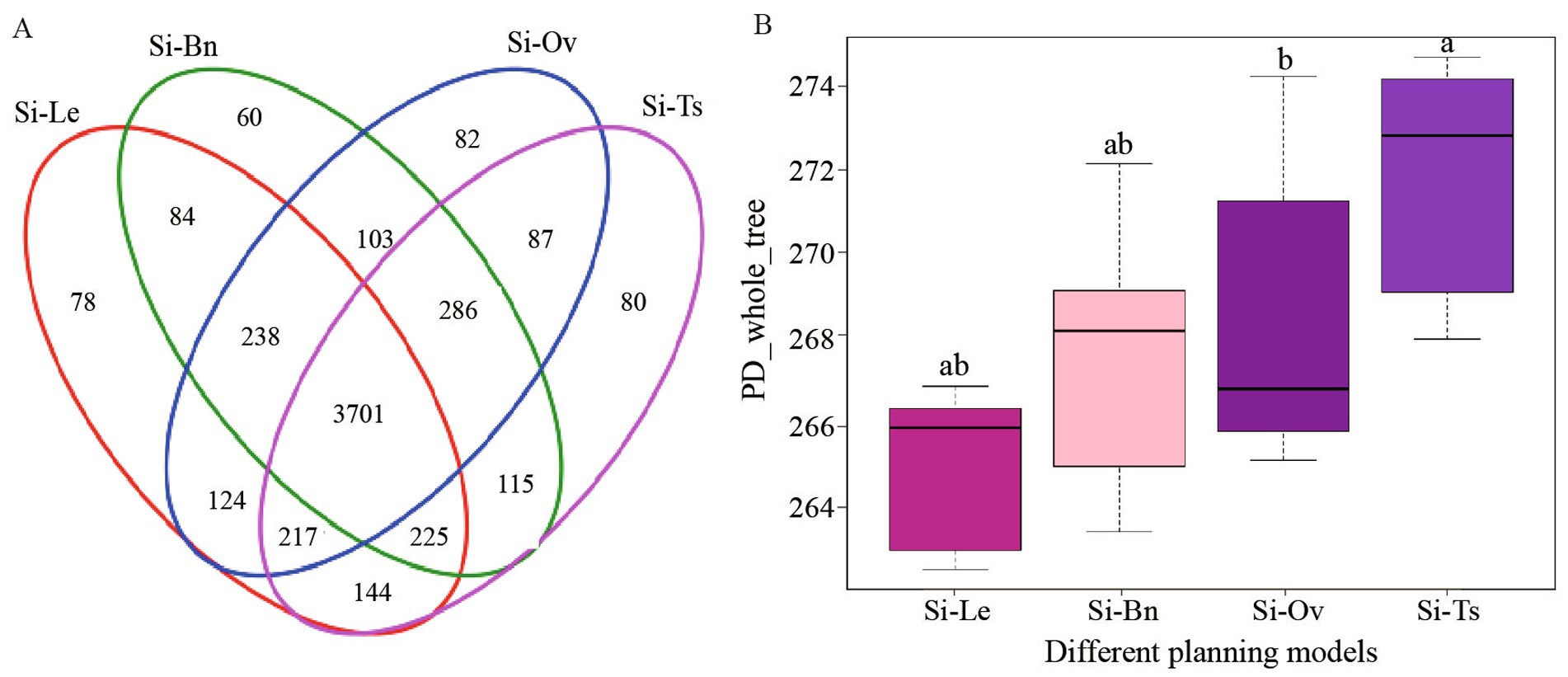
Figure 2. The differential analysis of bacterial communities diversity cross rotation patterns. (A) Venn diagram illustrating the differences in OTUs among planting models. Each color represents a different rotation pattern, with the numbers inside each oval indicating the total OTUs unique to that model. Overlapping areas represent common OTUs shared between different planting models. (B) Alpha diversity analysis of bacterial communities. The horizontal axes represent different rotation pattern, the vertical axes represent pedigree diversity indexes. The scales of horizontal and vertical axes are relative distance and have no practical significance.
Hierarchical clustering was employed to analyze the evolutionary distances of bacteria at the OTU level across different rotation patterns. The branch lengths in the evolutionary tree represent the distances between samples: shorter branch lengths indicate higher similarity between samples, which cluster more closely together. These results are illustrated in Figure 3A, where the Si-Ts group is distinctly separated from the other three groups. Phylogenetic diversity, based on distance spectrum diversity, reflects the similarity among samples. The closer the points on the plot, the higher the similarity between the samples. Two key conclusions can be drawn from this analysis: Differences in community composition among samples within the same group can be identified. Variations in community composition among samples across different groups can be assessed based on the distances between groups. PCA reflects the difference of multiple groups of data on the two-dimensional coordinate graph, and the coordinate axis can reflect the two eigenvalues of the variance value to the maximum. The difference and distance between samples can be reflected by analyzing the genetic composition of different samples. The more similar the composition of the samples, the closer the distance reflected in the PCA diagram. The soil samples in the same crop rotation pattern are clustered together, and the soil samples in different crop rotation patterns have a certain distance, reflecting the repeatability of the samples in the same rotation pattern and the differences between the samples in different crop rotation patterns (Figure 3B).
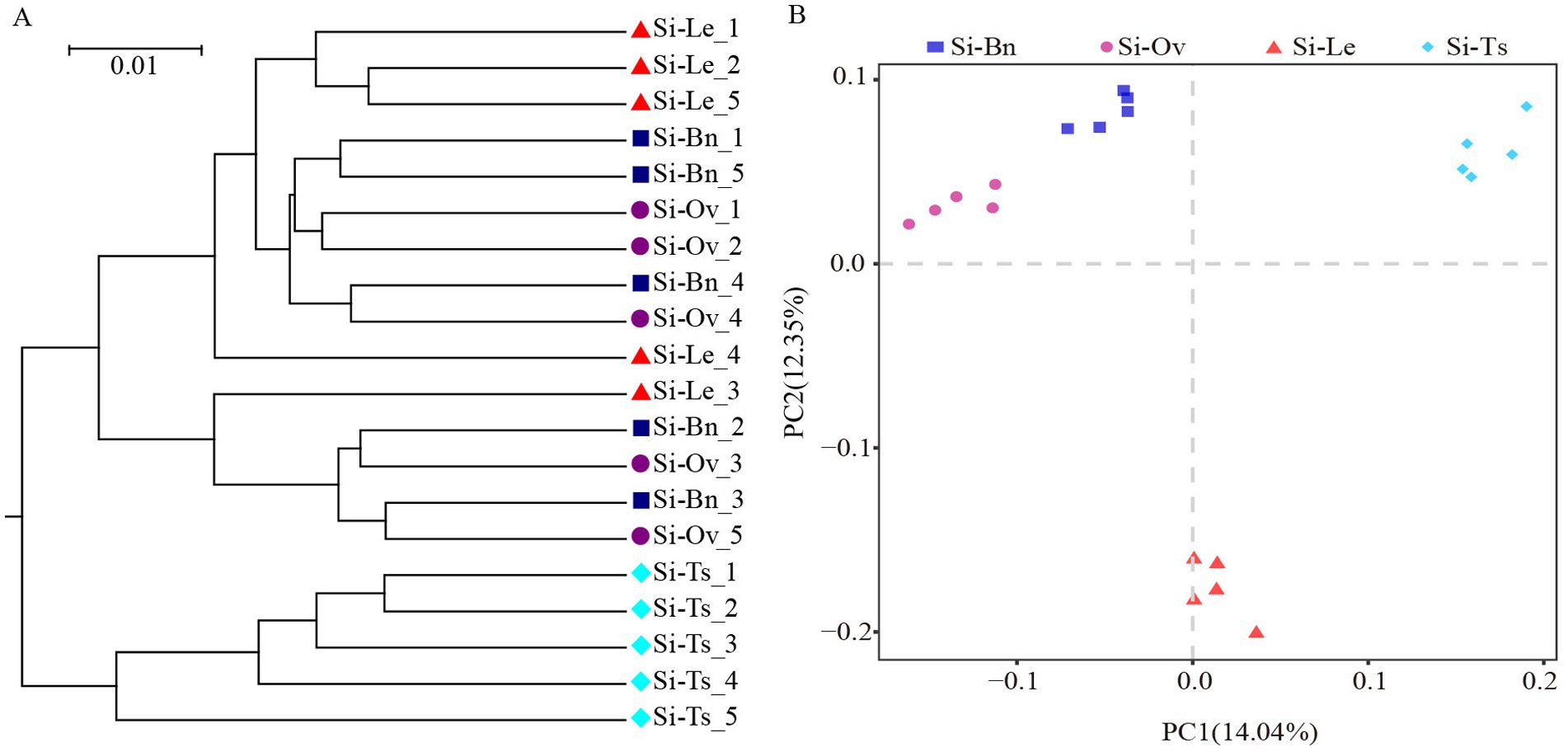
Figure 3. The hierarchical clustering and principal component analysis of bacterial communities. (A) Hierarchical clustering analysis of bacterial communities under different rotation patterns. Each color or shape represents a distinct sample or group, with branch lengths indicating relative distances between samples, reflecting their evolutionary similarity. (B) Principal Component Analysis (PCA) of beta diversity indices. The horizontal (PC1) and vertical (PC2) axes represent the primary factors influencing genetic composition variations among the sample groups. These axes are scaled to reflect relative distances without practical units and can be interpreted based on the characteristic features of the samples. The blue squares represent the soil samples of Si-Bn rotation pattern, The purple circles represent the soil samples of Si-Ov rotation pattern, The green rhomboids represent the soil samples of Si-Ts rotation pattern, The red triangles represent the soil samples of Si-Le rotation pattern.
3.4 Analysis of bacterial community composition
High-throughput sequencing was conducted to analyze the composition of soil rhizosphere bacterial community. The analysis results revealed that: The bacterial communities cross all samples were mainly composed of Proteobacteria, Actinobacteria, Acidobacteria, Chloroflexi, and Bacteroidetes. Among the groups, the proportion of Proteobacteria was highest in the Si-Ts group (30.2%), followed by the Si-Bn (26.7%), Si-Ov (25.8%), and Si-Le (25.2%) groups. The second most abundant phylum was Actinomycetes, accounting for 20.7 to 23.1% across the groups. The variance analysis of the top 60 genera in terms of relative abundance identified 29 genera with significant differences in different rotation patterns. These included: 6 OTUs belong to Proteobacteria, such as Microvirga, Bradyrhizobium, Devosia, Streptomyces, Steroidobacter, Dongia, Azohydromonas and Shinella granulosa; 8 OTUs belong to actinomycetes, such as Pseudarthrobacter, Blastococcus, Solirubrobacter and Rubrobacter. Streptococcus (Ohtaekwangia) and Terrimonas belonged to bacteroidetes were showed in Figure 4.
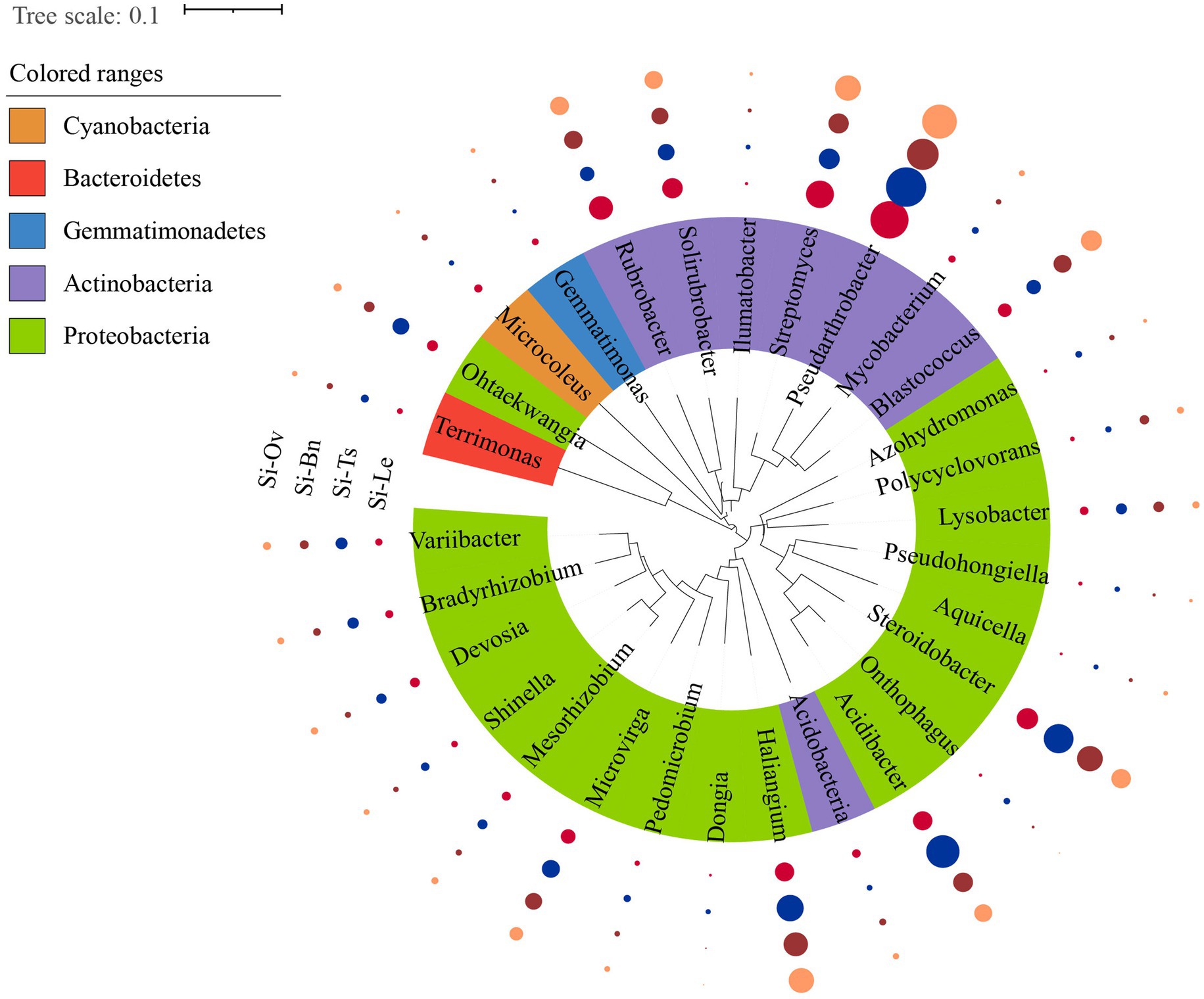
Figure 4. Differential analysis of bacterial genera across rotation patterns. Colored circles represent the relative abundance of each genus. The higher the significant difference, the bigger the circle’s diameter. Taxonomic dendrogram shows the inferred evolutionary relationship of the enriched microbiota of each sample. The total relative abundances of all genera and their significant effects across soil compartments are detailed in Table 3.
Compared with Si-Le group, the relative proportions of Pseudohongiella in Si-Ts, Si-Bn and Si-Ov groups were increased by 12.8, 13.8, and 1.25%, respectively. The relative proportion of Microvirga in Si-Ts and Si-Bn group was 30.6% and 15.2% higher than that in Si-Le group, while the relative proportion of Microvirga in Si-Ov group was 19.6% lower than that in Si-Le group. The relative proportions of Bradyrhizobium and Mesorhizobium in Si-Ts group were 41.9 and 33.2% higher than those in Si-Le group. While the relative proportion of Bradyrhizobium in Si-Bn and Si-Ov groups was significantly reduced by 5.1 and 14.0% compared with that in Si-Le group. The relative proportion of Mesorhizobium in Si-Bn and Si-Ov groups was significantly decreased, the reduction ratio was 23.6 and 21.1% compared with that in Si-Le group. The relative proportions of Devosia in Si-Ts, Si-Bn and Si-Ov groups were 61.6, 1.7 and 18.5% higher than those in Si-Le group. The relative proportion of Shinella granules in Si-Ts group was significantly increased by 30.0% compared with Si-Le group, while the relative proportion in Si-Bn and Si-Ov group was significantly decreased by 23.7 and 21.7% compared with Si-Le group. The relative proportions of Azohydromonas in Si-Ts, Si-Bn, and Si-Ov groups were 92.1, 25.0, and 138.4% higher than those in Si-Le group, respectively. The relative proportion of Pseudomonas (Dongia) in Si-Ts group was significantly increased by 81.3% compared with Si-Le group, while the relative proportion in Si-Bn and Si-Ov group was significantly decreased by 27.5 and 47.6% compared with Si-Le group. The relative proportions of Haliangium in Si-Ts, Si-Bn and Si-Ov groups were 63.4, 22.0, and 62.7% higher than those in Si-Le group. The relative proportion of Lysobacter in Si-Ts and Si-Bn group was 48.9 and 47.3% higher than that in Si-Le group. The relative ratio of Steroidobacter in Si-Ts group was significantly increased by 10.6% compared with Si-Le group, while the relative ratio in Si-Bn and Si-Ov group was significantly decreased by 34.4 and 16.4% compared with Si-Le group. The proportion of Ohtaekwangia in Si-Ts group was significantly increased by 158% compared with Si-Le group, but the proportion of Ohtaekwangia in Si-Bn and Si-Ov group was significantly decreased by 22.9 and 11.3% compared with Si-Le group. The relative ratio of Ilumatobacter in Si-Ts, Si-Bn, and Si-Ov groups was increased by 24.0, 12.1, and 51.3% compared with Si-Le group, respectively. The relative proportions of Streptomyces in Si-Ts, Si-Bn, and Si-Ov groups were 18.8, 43.5, and 21.9% higher than that in Si-Le group (Table 3).
3.5 Relationship between soil properties and bacterial community composition
To analyze the relationship between soil bacterial flora and soil physical and chemical properties across different rotation patterns, correlations were examined between environmental factors and 29 bacterial genera that showed significant differences among the patterns. The result revealed that each of the 29 bacterial genera was significantly correlated with at least one soil physicochemical property. Pseudarthrobacter, Dongia, VosseliaDevosia, Bradyrhizobium, Mesorhizobium, and Shinella were significantly positively correlated with available phosphorus and organic matter in soil. Azohydromonas, Terrimonas, Streptomyces, Steroidobacter, and Ohtaekwangia were only significant positively correlated available phosphorus in soil. Microcoleus had a significant negative correlation with alkali nitrogen and available potassium of soil species. There was a significant negative correlation between Haliangium and soil pH. Blastococcus exhibited a significant negative correlation with soil organic matter. These relationships are illustrated in Figure 5 and summarized in Table 4.
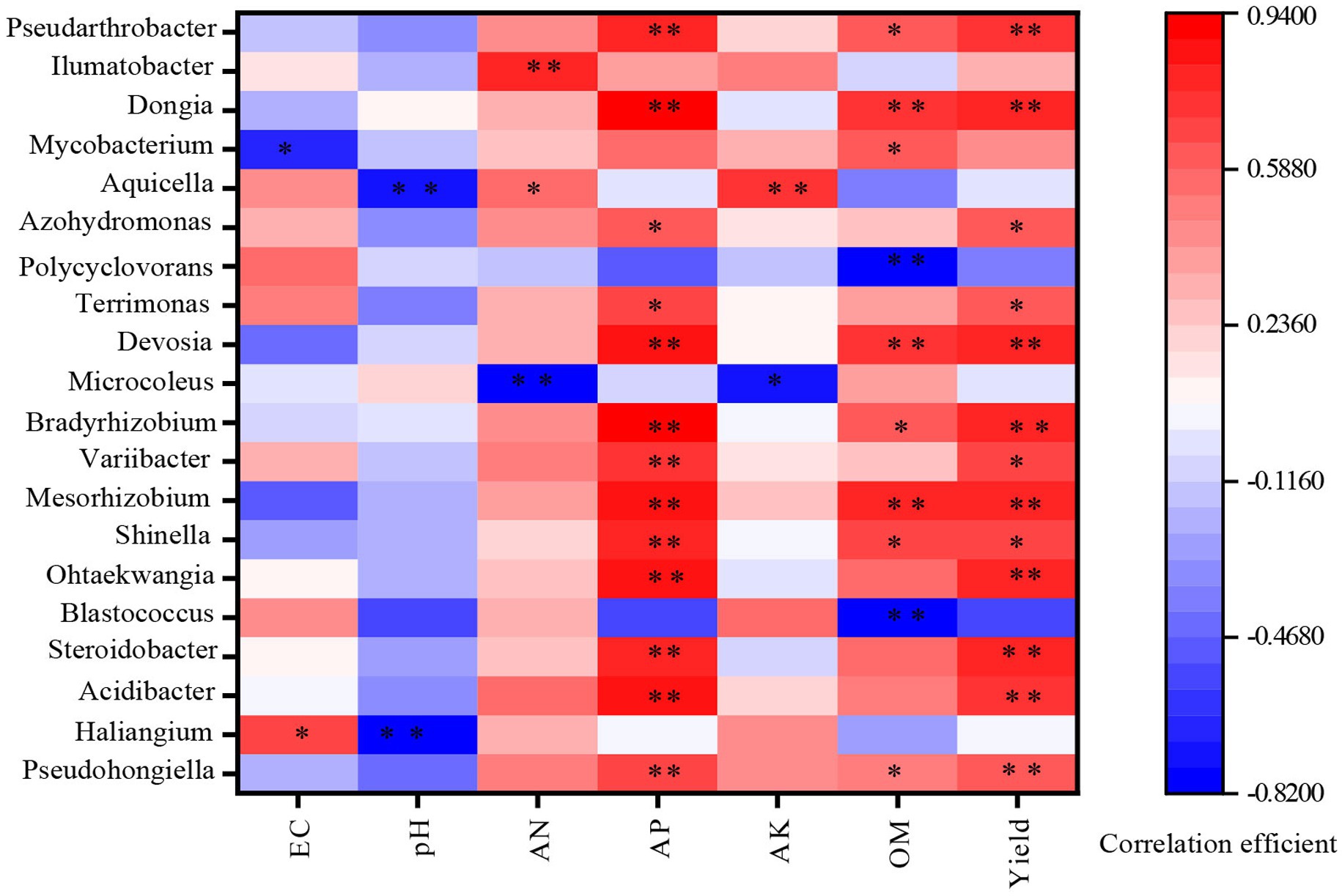
Figure 5. Pearson correlations between differential genus and physicochemical properties. pH, pH Value; EC, electric conductivity; OM, organic matter; AP, available potassium; AK, available phosphorus; AN, alkali-hydrolyzed nitrogen; Yield, grain yield. *p < 0.05, **p < 0.01.
To evaluate the impact of environmental factors on soil bacterial community structure, redundancy analysis (RDA) was conducted to explore the relationships between these factors and the bacterial community. The analysis revealed that soil alkali-hydrolyzed nitrogen, available potassium, available phosphorus, and organic matter were positively correlated with the bacterial community structure across all samples, while pH and electrical conductivity (EC) were negatively correlated. These findings are illustrated in Figure 6. RDA1 and RDA2 accounted for 24.7 and 17.6% of the total variation, respectively. Among the individual environmental factors, alkali-hydrolyzed nitrogen contributed the most, explaining 21.6% of the variation with a contribution rate of 28.8%. Available phosphorus explained 18% of the variation, with a contribution rate of 23.9%. A significant correlation was observed between soil alkali-hydrolyzed nitrogen, available phosphorus, and bacterial community structure (Table 5). In summary, alkali-hydrolyzed nitrogen and available phosphorus were identified as the key factors driving structural changes in the soil bacterial community (p < 0.05).

Figure 6. RDA of bacterial communities and environmental factor for individual samples. pH, pH Value; EC, electric conductivity; OM, organic matter; AP, available potassium; AK, available phosphorus; AN, alkali-hydrolyzed nitrogen; Yield, grain yield.
4 Discussion
4.1 Effects of different rotation patterns on millet yield and yield components
Crop rotation has been shown to enhance millet yield (Li et al., 2020). This study, revealed that millet yield significantly increased under millet rotation systems involving Triticum secale, Brassica napus L., and Orychophragmus violaceus compared to the fallow-millet system in 2021 and 2022. Among these, the Triticum secale-millet rotation showed the highest yield improvement. Although the millet yield were declined in 2022 compared to that in 2021, but the millet yields in different manure-millet rotation patterns were still higher than that in miller-fallow rotation pattern. This year-to-year variation may be attributed to climatic factors, including total precipitation, precipitation distribution, accumulated temperature, and sunlight duration (Xia et al., 2023). The fallow-millet rotation exhibited the most pronounced yield reduction in 2022, potentially due to continuous cropping issues. These issues often lead to the accumulation of pests and diseases, as well as shifts in the soil microbial community (Tian et al., 2017; Pavithran et al., 2022). Returning green manure to the soil has been reported to enhance crop yield components (Trivedi et al., 2016). Consistent with this, our study demonstrated that the Triticum secale-millet rotation significantly increased the 1,000-grain weight of millet, while the Orychophragmus violaceus-millet rotation significantly improved spike grain weight. Yield was found to be significantly positively correlated with 1,000-grain weight and grain weight per spike, aligning with findings from other studies (Qian et al., 2022). These results suggest that incorporating green manure crops like Triticum secale, Brassica napus L., and Orychophragmus violaceus can improve important economic traits of millet, ultimately boosting overall yield.
4.2 Effects of different rotation patterns on soil physical and chemical properties
Effective irrigation and well-designed crop rotation systems are critical for enhancing soil nutrient profiles (Wang L. et al., 2022; Wang X. Y. et al., 2022). Crop rotation can increase the soil productivity (Wu et al., 2025). This study demonstrated that compared to the fallow-millet system, Triticum secale-millet and Brassica napus L.-millet rotations significantly increased the organic matter content in the topsoil. This can be attributed to the high carbohydrate content in Triticum secale and Brassica napus L., which promotes the accumulation of organic matter while accelerating soil mineralization (Gao et al., 2021). These findings are consistent with previous studies (Li et al., 2019). Additionally, green manure crops have been shown to rejuvenate soil humus, enhance soil organic matter, and improve phosphorus availability (Zhao et al., 2019). Changes in the soil microbial community likely play a central role in improving the efficiency of soil nutrient utilization (Latkovic et al., 2020). The results of this study highlighted a significant increase in soil available phosphorus under the Triticum secale-millet rotation compared to the fallow-millet system. The RDA analysis further revealed a strong positive correlation between soil bacteria, alkali-hydrolyzed nitrogen, and available phosphorus. Moreover, available phosphorus was highly correlated with yield and specific bacterial taxa exhibiting significant differences across cropping patterns in Figure 4. These findings suggest that the Triticum secale-millet rotation enhances the microbial capacity to absorb and degrade phosphorus, thereby improving the availability of phosphorus and promoting millet yield.
4.3 Effects of different rotation patterns on soil bacterial community structure
Soil microorganisms play a crucial role in influencing plant productivity by establishing symbiotic, parasitic, or mutualistic relationships with plants (Van der heijden et al., 2008). Among these, bacteria are the dominant components of soil microorganisms, and their diversity and population composition are critical indicators of soil health and vitality (Amato et al., 2013). Research has demonstrated that crop rotation, as opposed to continuous cropping, enhances microbial diversity, alters population structures, and promotes biological activity (Detheridge et al., 2016; Chapatto et al., 2012). Greater microbial diversity enriches the soil environment, contributing to the stability and health of the soil ecosystem (Pietras et al., 2013; Wang et al., 2017). In this study, 16S RNA high-throughput sequencing was conducted to analyze the rhizosphere microbial communities of millet under four different cropping systems: Triticum secale-millet, Brassica napus L.-millet, Orychophragmus violaceus-millet, and millet monoculture. The results of alpha and beta diversity analyses revealed that different rotation patterns significantly enhanced rhizosphere bacterial diversity to varying extents. Among the cropping patterns, the diversity of soil rhizosphere bacteria ranked as follows: Triticum secale-millet rotation > Brassica napus-millet rotation > Orychophragmus violaceus-millet rotation > fallow-millet.
The degree of improvement in microbial community structure and composition varied depending on the crop rotation combination (Chaer et al., 2009). This study showed that rotation systems involving millet with other crops led to changes in soil bacterial composition. The relative abundances of Proteobacteria (e.g., Pseudohongiella, Dongia, Azohydromonas, Microvirga, Bradyrhizobium, Mesorhizobium, Devosia, Haliangium, Lysobacter, and Steroidobacter), Bacteroidetes (e.g., Ohtaekwangia), and Actinobacteria (e.g., Ilumatobacter and Streptomyces) were higher in the Triticum secale-millet, Brassica napus-millet, and Orychophragmus violaceus-millet rotation modes compared to millet monoculture. Among these, the Triticum secale-millet rotation exhibited the highest species richness and relative abundance. Correlation analysis further demonstrated a significant positive relationship between these bacterial taxa and millet yield. Previous studies have highlighted the role of Pseudomonas as a key rhizosphere-promoting microorganism with biocontrol functions, producing chitinase and lysozyme while enhancing plant nutrition (Ai et al., 2018; Gopalakrishnan et al., 2015). The increased availability of soil phosphorus (P) has been linked to higher bacterial diversity and abundance, potentially due to its role in adsorption and decomposition processes (Han et al., 2017). In this study, the relative abundance of several genera within Bacteroidetes and Proteobacteria was significantly higher in the rotation systems than in fallow-millet, while the relative abundance of Acidobacteria decreased by 19.1, 26.8, and 33.44% in the Brassica napus-millet, Orychophragmus violaceus-millet, and Triticum secale-millet rotations, respectively (Table 2).
Soil physical and chemical properties were positively correlated with the abundance of Bacteroidetes and Proteobacteria, but negatively correlated with Acidobacteria. Previous research has established that organic matter content is positively associated with Bacteroidetes and Proteobacteria, but negatively associated with Acidobacteria (Li et al., 2017). The findings of this study align with those observations, further underscoring the beneficial impact of crop rotation on soil bacterial communities and overall soil health.
5 Conclusion
The rotation of Triticum secale, Brassica napus, and millet proved effective in enhancing the accumulation of organic matter and available phosphorus in surface soil. These rotation systems significantly increased the abundance of beneficial bacterial communities in the rhizosphere, while reducing the prevalence of harmful bacterial populations. Additionally, they contributed to improved millet yield by enhancing yield components. Among the tested rotation modes, the Triticum secale-millet rotation demonstrated the greatest potential for enriching beneficial soil bacteria and maintaining stable and high millet yields, making it particularly suitable for the low plain areas of Hebei Province. This study will provide a theoretical basis for advancing crop rotation strategies and offer technical support for sustainable agricultural development.
Data availability statement
The datasets presented in this study can be found in online repositories. The names of the repository/repositories and accession number(s) can be found in the article/supplementary material.
Author contributions
GY: Conceptualization, Data curation, Formal analysis, Funding acquisition, Methodology, Software, Supervision, Validation, Writing – original draft, Writing – review & editing, Project administration. YH: Validation, Data curation, Formal analysis, Methodology, Writing – review & editing. PL: Data curation, Formal analysis, Methodology, Validation, Writing – review & editing. HH: Validation, Writing – review & editing, Conceptualization, Funding acquisition, Project administration, Resources, Supervision. ML: Conceptualization, Funding acquisition, Project administration, Resources, Supervision, Validation, Writing – review & editing.
Funding
The author(s) declare that financial support was received for the research and/or publication of this article. This work was funded by HAAFS Science and Technology Innovation Special Project (No. 2022KJCXZX-HZS-10), Construction of Modern Agricultural Industrial Technology System (No. CARS-06-14.5-B3).
Conflict of interest
The authors declare that the research was conducted in the absence of any commercial or financial relationships that could be construed as a potential conflict of interest.
Generative AI statement
The authors declare that no Gen AI was used in the creation of this manuscript.
Publisher’s note
All claims expressed in this article are solely those of the authors and do not necessarily represent those of their affiliated organizations, or those of the publisher, the editors and the reviewers. Any product that may be evaluated in this article, or claim that may be made by its manufacturer, is not guaranteed or endorsed by the publisher.
References
Ai, C., Zhang, S. Q., Zhang, X., Guo, D. D., Zhou, W., and Huang, S. M. (2018). Distinct responses of soil bacterial and fungal communities to changes in fertilization regime and crop rotation. Geoderma 319, 156–166. doi: 10.1016/j.geoderma.2018.01.010
Amato, K. R., Yeoman, C. J., Kent, A., Righini, N., Carbonero, F., Estrada, A., et al. (2013). Habitat degradation impacts black howler monkey (Alouatta pigra) gastrointestinal microbiomes. ISME J. 7, 1344–1353. doi: 10.1038/ismej.2013.16
Anurag, S., Singh, D. V., and Joshi, N. L. (1997). Effects of tillage and cropping systems on soil moisture balance and pearl millet yield. J. Agron. Crop Sci. 178, 251–257. doi: 10.1111/j.1439-037X.1997.tb00498.x
Chaer, G., Fernandes, M., Myrold, D., and Bottomley, P. (2009). Comparative resistance and resilience of soil microbial communities and enzyme activities in adjacent native forest and agricultural soils. Microbiol. Ecol. 58, 414–424. doi: 10.1007/s00248-009-9508-x
Chapatto, J. M., Sheflin, A. M., Manter, D. K., and Viaanco, J. M. (2012). Manipulating the soil microbiome to increase soil health and plant fertility. Biol. Fert. Soils 48, 489–499. doi: 10.1007/s00374-012-0691-4
Chavarría, D. N., Verdenelli, R. A., Serri, D. L., Restovich, S. B., Andriulo, A. E., Meriles, J. M., et al. (2016). Effect of cover crops on microbial community structure and related enzyme activities and macronutrient availability. Eur. J. Soil Biol. 76, 74–82. doi: 10.1016/j.ejsobi.2016.07.002
Cheng, X. K., Zhou, T., Liu, S. H., Sun, X. B., Zhou, Y. F., Xu, L., et al. (2023). Effects of climate on variation of soil organic carbon and alkali-hydrolyzed nitrogen in subtropical forests: a case study of Zhejiang Province, China. Forests 14:914. doi: 10.3390/f14050914
Detheridge, A., Brand, G., Fychan, R., Crotty, F., Sandefson, R., Griffith, G., et al. (2016). The legacy effect of cover crops on soil fungal populations in acereal rotation. Agricult. Ecosyst. Environ. 228, 49–61. doi: 10.1016/j.agee.2016.04.022
Diao, X. M., and Cheng, R. H. (2017). Current breeding situation of foxtail millet and common millet in China as revealed by exploitation of 15 years regional adaptation test data. Sci. Agricult. Sin. 50, 4469–4474. doi: 10.3864/j.issn.0578-1752.2017.23.001
Fu, X. L., Zhao, C. J., Ma, S. X., Tian, H. W., Dong, D. M., and Li, G. L. (2020). Determining available potassium in soil by laser-induced breakdown spectroscopy combined with cation exchange membrane adsorption. J. Anal. Atomic Spectr. 35, 2697–2703. doi: 10.1039/d0ja00394h
Gao, S. J., Cao, W. D., Zhou, G. P., and Rees, R. M. (2021). Bacterial communities in paddy soils changed by milk vetch as green manure: a study conducted across six provinces in South China. Pedosphere 31, 521–530. doi: 10.1016/S1002-0160(21)60002-4
Gopalakrishnan, S., Srinivas, V., Prakash, B., Sathya, A., and Vijayabharathi, R. (2015). Plant growth-promoting traits of Pseudomonas geniculata isolated from chickpea nodules. 3 Biotech 5, 653–661. doi: 10.1007/s13205-014-0263-4
Han, G. M., Lan, J. Y., Chen, Q. Q., Yu, C., and Bie, S. (2017). Response of soil microbial community to application of biochar in cotton soils with different continuous cropping years. Sci. Rep. 7:10184. doi: 10.1038/s41598-017-10427-6
Hao, X., Wang, G., Guo, E., Yang, H., Zhang, A., Cheng, Q., et al. (2022). Effects of continuous cropping and rotation on rhizosphere bacterial community structure of millet. J. Agro-Environ. Sci. 41, 585–596.
Horn, L. N., and Alweendo, T. E. (2011). Crop rotation of leguminous crops as a soil fertility strategy in pearl millet production systems. Innovations as key to the green revolution in Africa. Springer Netherlands 1, 1009–1014. doi: 10.1007/978-90-481-2543-2_102
Khan, M. I., Gwon, H. S., Alam, M. A., Song, H. J., Das, S., and Kim, P. J. (2020). Short term effects of different green manure amendments on the composition of main microbial groups and microbial activity of a submerged rice cropping system. Appl. Soil Ecol. 147:103400. doi: 10.1016/j.apsoil.2019.103400
Latkovic, D., Maksimovic, J., Dinic, Z., Pivic, R., Stanojkovic, A., and Stanojkovic-Sebic, A. (2020). Case study upon foliar application of biofertilizers affecting microbial biomass and enzyme activity in soil and yield related properties of maize and wheat grains. Biology (Basel) 9:452. doi: 10.3390/biology9120452
Leite, H. M. F., Calonego, J. C., Rosolem, C. A., Mendes, L. W., de Moraes, L. N., Grotto, R. M. T., et al. (2021). Cover crops shape the soil bacterial community in a tropical soil under no-till. Appl. Soil Ecol. 168:104166:104166. doi: 10.1016/j.apsoil.2021.104166
Li, F., Chen, L., Zhang, J. B., Yin, J., and Huang, S. M. (2017). Bacterial community structure after long-term organic and inorganic fertilization reveals important associations between soil nutrients and specific taxa involved in nutrient transformations. Front. Microbiol. 8:187. doi: 10.3389/fmicb.2017.00187
Li, B. H., Liu, X. M., Li, Z. L., Wang, G. P., Zhao, B. C., Xu, C., et al. (2024). Rotation with soybean improved weed control and foxtail millet yield. Agro-Basel 14:1622. doi: 10.3390/agronomy14081622
Li, F. D., Ren, J., Wimmer, S., Yin, C. B., Li, Z. Y., and Xu, C. X. (2020). Incentive mechanism for promoting farmers to plant green manure in China. J. Cleaner Prod. 267:122197:122197. doi: 10.1016/j.jclepro.2020.122197
Li, Y., Tian, H., Zhang, J., Lu, S., Xie, Z., Shen, W., et al. (2023). Detection of spatiotemporal changes in ecological quality in the Chinese mainland: trends and attributes. Sci. Total Environ. 884:163791. doi: 10.1016/j.scitotenv.2023.163791
Li, W., Yang, X., Huang, C., Xue, N., Xia, Q., Liu, X., et al. (2019). Effects of rapeseed green manure on soil fertility and bacterial community in dryland wheat field. Sci. Agricult. Sin. 52, 2664–2677. doi: 10.3864/j.issn.0578-1752.2019.15.010
Nascente, A. S., and Stone, L. F. (2018). Cover crops as affecting soil chemical and physical properties and development of upland rice and soybean cultivated in rotation. Rice Sci. 25, 340–349. doi: 10.1016/j.rsci.2018.10.004
Nielsen, D. C., and Vigil, M. F. (2017). Water use and environmental parameters influence proso millet yield. Field Crop Res. 212, 34–44. doi: 10.1016/j.fcr.2017.06.025
Pavithran, A., Krishnan, R., Somasundaram, E., and Chandrasekhar, C. N. (2022). Evaluation of foliar nutrition for yield maximization in foxtail millet (Setaria italica). Inter. J. Plant Soil Sci. 571–576, 571–576. doi: 10.9734/ijpss/2022/v34i2131302
Pietras, M., Rudawska, M., Leski, T., and Karlinski, L. (2013). Diversity of ectomycorrhizal fungus assemblages on nursery grown European beech seedlings. Ann. For. Sci. 70, 115–121. doi: 10.1007/s13595-012-0243-y
Qian, Z., Zhu, K., Zhuang, S., and Tang, L. (2022). Soil nutrient cycling and bacterial community structure in response to various green manures in a successive eucalyptus (Eucalyptus urophylla × Eucalyptus grandis) plantation. Land Degrad. Dev. 33, 2809–2821. doi: 10.1002/ldr.4331
Rognes, T., Flouri, T., Nichols, B., Quince, C., and Mahé, F. (2016). Vsearch: a versatile open source tool for metagenomics. PeerJ 4:e2584. doi: 10.7717/peerj.2584
Sammauria, R., Meena, O. P., Yadav, M. R., Gupta, K. C., Gupta, A. K., and Yadav, H. L. (2020). Crop diversification of predominant pearl millet based cropping system for higher productivity, resource-use efficiency and profitability in semi-arid Rajasthan. Legum. Res. 43:LR-4077. doi: 10.18805/LR-4077
Segata, N., Izard, J., Waldron, L., Gevers, D., Miropolsky, L., Garrett, W. S., et al. (2011). Metagenomic biomarker discovery and explanation. Genom. Biol. 12:R60. doi: 10.1186/gb-2011-12-6-r60
Shen, Y., Zhang, T. T., Cui, J. C., Chen, S. Y., Han, H. F., and Ning, T. Y. (2021). Subsoiling increases aggregate-associated organic carbon, dry matter, and maize yield on the North China plain. PeerJ 9:e11099. doi: 10.7717/peerj.11099
Tian, Q., Taniguchi, T., Shi, W. Y., Li, G., Yamanaka, N., Du, S., et al. (2017). Land-use types and soil chemical properties influence soil microbial communities in the semiarid Loess Plateau region in China. Sci Rep. 7:45289. doi: 10.1038/srep45289s
Trivedi, P., Delgado-Baquerizo, M., Anderson, I. C., and Singh, B. K. (2016). Response of soil properties and microbial communities to agriculture: implications for primary productivity and soil health indicators. Front. Plant Sci. 7:990. doi: 10.3389/fpls.2016.00990
Van der heijden, M. G., Bardgett, R. D., and Van straalen, N. M. (2008). The unseen majority: soil microbes as drivers of plant diversity and productivity in terrestrial ecosystems. Ecol. Lett. 11, 296–310. doi: 10.1111/j.1461-0248.2007.01139.x
Wan, S., Hou, J., Zhao, J., Clarke, N., Kempenaar, C., and Chen, X. (2024). Predicting soil organic matter, available nitrogen, available phosphorus and available potassium in a black soil using a nearby hyperspectral densor dystem. Sensors (Basel) 24:2784. doi: 10.3390/s24092784
Wang, L., Cui, Y. Z., Wu, Y. H., Hao, X. S., Zhang, C. H., Wang, J. Y., et al. (2022). Effects of rice stalks mulching combined with green manure (Astragalus smicus L.) incorporated into soil and reducing nitrogen fertilizer rate on rice yield and soil fertility. Acta Agron. Sin. 48, 952–961. doi: 10.3724/SP.J.1006.2022.12007
Wang, X. Y., Duan, Y., Zhang, J., Ciampitti, I. A., Cui, J. W., Qiu, S. J., et al. (2022). Response of potato yield, soil chemical and microbial properties to different rotation sequences of green manure-potato cropping in North China. Soil Till. Res. 217:105273:105273. doi: 10.1016/j.still.2021.105273
Wang, R., Zhang, H. C., Sun, L. G., Qi, G. F., Chen, S., and Zhao, X. Y. (2017). Microbial community composition is related to soil biological and chemical properties and bacterial wilt outbreak. Sci. Rep. 7:343. doi: 10.1038/s41598-017-00472-6
Wei, G. S., Shan, D. P., Li, G. Z., Li, X., Tian, R. M., He, J. G., et al. (2020). Prokaryotic communities vary with floc size in a biofloc-technology based aquaculture system. Aquaculture 529:725632. doi: 10.1016/j.aquaculture.2020.735632
Wu, H., Liu, E., Jin, T., Liu, B., Gopalakrishnan, S., Zhou, J., et al. (2025). Crop rotation increases Tibetan barley yield and soil quality on the Tibetan Plateau. Nat Food. 6:151–160. doi: 10.1038/s43016-024-01094-8
Xia, Z., He, Y., Korpelainen, H., Niinemets, Ü., and Li, C. (2023). Allelochemicals and soil microorganisms jointly mediate sex-specific belowground interactions in dioecious Populus cathayana. New Phytol. 240, 1519–1533. doi: 10.1111/nph.19224
Xu, J., Si, L., Zhang, X., Cao, K., and Wang, J. H. (2023). Various green manure-fertilizer combinations affect the soil microbial community and function in immature red soil. Front. Microbiol. 14:1255056. doi: 10.3389/fmicb.2023.1255056
Yang, R., Song, S. J., Chen, S. Y., Du, Z. Y., and Kong, J. Q. (2023). Adaptive evaluation of green manure rotation for a low fertility farmland system: impacts on crop yield, soil nutrients, and soil microbial community. Catena 222:106873:106873. doi: 10.1016/j.catena.2022.106873
Zeng, Q. C., and An, S. S. (2021). Identifying the biogeographic patterns of rare and abundant bacterial communities using different primer sets on the loess plateau. Microorganisms 9:139. doi: 10.3390/microorganisms9010139
Zhang, X., Ma, Y., Chen, F., and Wang, Y. (2018). Effects of vacuum microwave drying on the nutrition and quality characteristics of millet and Chinese yam. Cereals Oils 31, 34–38. doi: 10.3969/j.issn.1008-9578.2018.04.010
Zhang, X. X., Zhang, R. J., Gao, J. S., Wang, X. C., Fan, F. L., Ma, X. T., et al. (2017). Thirty-one years of rice-rice-green manure rotations shape the rhizosphere microbial community and enrich beneficial bacteria. Soil Biol. Biochem. 104, 208–217. doi: 10.1016/j.soilbio.2016.10.023
Zhang, L., Zhu, J., Zhang, Y., Xia, K., Yang, Y., Wang, H., et al. (2024). Maize, peanut, and millet rotations improve crop yields by altering the microbial community and chemistry of sandy saline-alkaline soils. Plants (Basel). 13:2170. doi: 10.3390/plants13152170
Zhao, X. M., Zhu, M. L., Guo, X. X., Wang, H. B., Sui, B., and Zhao, L. P. (2019). Organic carbon content and humus composition after application aluminum sulfate and rice straw to soda saline-alkaline soil. Environ. Sci. Pollut. Res. Int. 26, 13746–13754. doi: 10.1007/s11356-018-2270-1
Zhu, H., Yuan, X. Y., Ye, H. M., Cheng, J., Mao, Z. Q., Han, N., et al. (2021). Comparison of available nitrogen and phosphorus characteristics in the land-water transition zone of different watersheds and their environmental significance. Huanjing Kexue 42, 2787–2795. doi: 10.13227/j.hjkx.202009183
Keywords: green manure-foxtail millet rotation, soil physicochemical properties, bacterial community, high-throughput sequencing, foxtail millet yield
Citation: Yu G, Han Y, Liu P, Hao H and Li M (2025) Response of foxtail millet yield, soil chemical property and bacterial community to different green manure-foxtail millet rotation models in North China. Front. Microbiol. 16:1558354. doi: 10.3389/fmicb.2025.1558354
Edited by:
Bin Zhou, Chinese Academy of Tropical Agricultural Sciences, ChinaCopyright © 2025 Yu, Han, Liu, Hao and Li. This is an open-access article distributed under the terms of the Creative Commons Attribution License (CC BY). The use, distribution or reproduction in other forums is permitted, provided the original author(s) and the copyright owner(s) are credited and that the original publication in this journal is cited, in accordance with accepted academic practice. No use, distribution or reproduction is permitted which does not comply with these terms.
*Correspondence: Hongbo Hao, MTU2MDMxODg5MjlAMTI2LmNvbQ==; Mingzhe Li, Z3V6aWtldGlAMTYzLmNvbQ==
 Guohong Yu
Guohong Yu Ya Han
Ya Han Pengcheng Liu1
Pengcheng Liu1